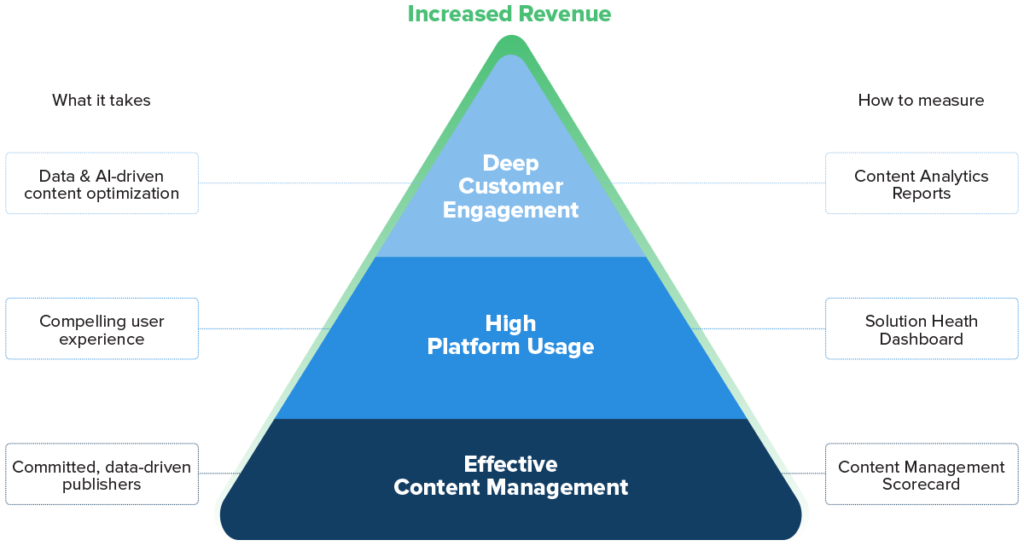One of the biggest advantages of companies with successful sales enablement strategies is their ability to maintain focus. From content mapping through launch and optimization, they’re clear on why they invested, where they’re going, who is involved, and the steps required to reach their goals. Today we’ll share a framework for how they do it, courtesy of the Highspot services team.
Platform Value Drivers
Revenue: your sales reps live by it, your marketers are scored against it, and your C-suite monitors it daily. Illustrated below is a depiction of the ways sales enablement contributes to this all-important metric.

One of the reasons we like this value pyramid is that it applies equally to sales and marketing teams. For example, at the foundational level, the ability for sales teams to quickly access the content they need is a reflection of how easy it is for marketing to make all of their company’s best-performing content available on a single platform. At the next-highest level, platform usage is directly related to the positive experiences and success of other users from both marketing and sales. At the top, customer engagement is a clear-cut indicator of whether or not platform features are capable of driving the revenue – and value – anticipated from any sales enablement investment. Finally, all activities lead to increased revenue, the ultimate KPI for sales and marketing.
Putting the Model to Work: Three Key Steps
As recently highlighted in SiriusDecisions’s State of Sales Enablement 2017, 74% of surveyed organizations plan to increase their sales enablement investment in the next year, with many up-leveling the responsibilities of their Sales Enablement teams. In addition and as shared in Highspot’s State of Sales Enablement 2017, more than 75% of respondents from companies using sales enablement tools reported higher year-over-year sales, the majority within an environment of increasingly complex sales processes.
These and other data points are signs that the attention devoted to sales enablement is on the rise. They also encourage deep understanding of the value pyramid and its applicability to specific opportunities. Here are a few suggestions on how to achieve similar results at your company.
- Focus on your foundation
From the technology industry to financial services, manufacturing, medical devices, consumer products, and others, the nearest-term objective of sales enablement buyers is getting their content under control. As outlined in our Best Practices series, this requires a combination of team alignment, modern and quickly scalable technology, and a vision for how your sales enablement platform will be managed over the long haul.
During this phase, your emphasis should be on activities that establish and maintain platform commitment. This means bringing aboard your full roster of publishers from sales and marketing, and ensuring their approach to sales enablement is data-driven. At Highspot, we help customers accomplish this by sharing content performance scorecards and related insights on where content is performing and where it’s missing the mark. Scorecards help solidify content management strategies and increase the probability of success farther up the pyramid.
- Monitor your usage
In sales enablement as elsewhere, platform value is directly related to usage levels. The more sales and marketing teams are publishing, customizing, sharing, and analyzing content on their sales enablement platform, the higher the likelihood they’ll recognize the full benefits of their investment. For example, AI-driven features such as search, recommendations, engagement, and revenue attribution yield deeper insights and more accurate results with greater usage.
Key contributors to high usage include: platform integrations, user experiences, and the range of scenarios in which your sales enablement platform delivers flawless results. Another way we help customers optimize usage is by setting up a solution health dashboard. The dashboard, in conjunction with the previously mentioned content scorecard, provides sales enablement leaders with the intelligence they need to continue ascending the value pyramid.
- Optimize for Customer Engagement
It has been widely referenced that approximately two-thirds of content goes unused and therefore generates zero ROI. Optimizing for customer engagement centers on identifying your highest-performing content, organizing and prioritizing it, and leveraging what you’ve learned to deliver more of the same. In summary, if the content you’ve worked so hard to manage and the platform on which you’ve generated usage isn’t driving engagement, then you’re falling short of your goal.
This is where having a culture and tools to support AI-driven optimization is critically important. It’s also where content analytics reports uplevel visibility into content that is (and isn’t) driving engagement, as well as who is (and is not) doing their part to elevate top-line performance.
Front-and-Center, Start-to-Finish
By focusing on how every content strategy decision contributes to revenue growth, forward-thinking businesses are using sales enablement to generate more effective customer conversations. They’re keeping the goals of modern sales enablement where they need to be and pursuing revenue growth with intelligence and tenacity. In short, they’re turning their focus into a force. And so can you.




